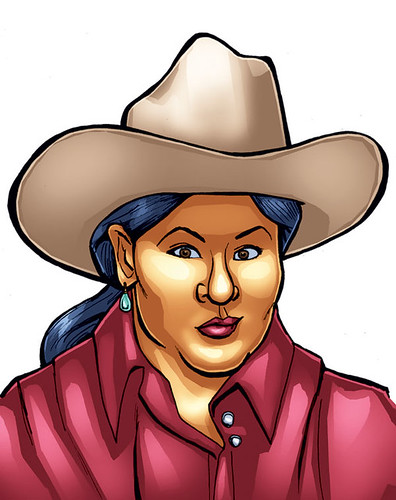 Bitch's series of interviews with webcomic creators, Beyond the Panel, returns with Arigon Starr, the multitalented force behind the comic-book-style webcomic Super Indian. Below, she tells Bitch about her history in comics, Native superheroes, geek culture, and what she'd like people to take away from her work.
Bitch's series of interviews with webcomic creators, Beyond the Panel, returns with Arigon Starr, the multitalented force behind the comic-book-style webcomic Super Indian. Below, she tells Bitch about her history in comics, Native superheroes, geek culture, and what she'd like people to take away from her work.
RMJ: How did you get into comics?
AS: I grew up on comics and by the time I was old enough to hold a crayon, I was drawing them. When I say “comics” I mean the Sunday funnies, “Archie,” “Mad,” “Creepy” and “Eerie,” plus the worlds of DC and Marvel. Will Eisner, Jack Kirby, Dave Gibbons, Neal Adams, John Byrne, Berni Wrightson, and Mort Drucker are some of my all-time favorite artists and gave me lots of inspiration.
Even as I pursued a career in the entertainment industry, I kept drawing. Super Indian is the first time I’ve combined my writing and drawing skills for a full-fledged comic series.
RMJ: What drew you to the superhero genre?
AS: There aren’t many Native American superheroes and even fewer that have been created and drawn by Native Americans. In mainstream comics there were Forge and Dani Moonstar in X-Men, but they aren’t as well-known as Batman or Iron Man. You can read a detailed history of Native characters in Michael Sheyashe’s book Native Americans in Comic Books: A Critical Study.
However, the tide is turning. There’s a group of Native artists and writers like Teddy Tso, Jon Proudstar, Jacques LaGrange, Roy Boney, Ryan Huna Smith, and Weshoyot Alvitre working in the comic industry and creating their own comic books.
The thing I love about superhero stories is someone normal transforming into the extraordinary. How would Wolverine or Wonder Woman be different if they came from an Indian nation? The superhero genre lets you explore the fantastical and have fun while you’re doing it.
When I describe the “sitch” of Super Indian—a rez boy eats tainted commodity cheese and gains super powers—it gets a big laugh. I took a lighter approach to the superhero world because my artistic career is filled with humor—everything from my song “Junior Frybread” which is about a larger-than-life Indian man who’s tasted all kinds of tribal frybread recipes, to my one-woman play “The Red Road,” which is a comedic take on Native life in the late 1970s.
RMJ: Your protagonist, Hubert Logan, has not one but two alter egos separate from his secret identity—superhero Super Indian and blogger Rez Boy. What do each of these personas represent?
AS: Super Indian is the “best” of Hubert Logan. He trained with his elders to learn the ways of his tribe, and he understands and respects his growing list of super powers. This persona always does the right thing and charges into dangerous situations without fear.
Hubert Logan, on the other hand, is a young man most folks would overlook or even tease for being a “geek.” He’s a janitor at the local Bingo Hall, reads, watches too many action thrillers, and spends most of his time with his uber-intelligent talking dog Diogi and his goofy sidekick/friend General Bear.
Hubert’s online persona, Rez Boy, is born out a need to step out of the shadow of his brilliant superhero alter ego. Can a person be jealous of himself? Oh yes! Maybe I’ve read too many celebrity biographies, but it seems that people who do extraordinary things always end up feeling like no one knows or likes the “real” them.
RMJ: Technology and nerd culture is a big part of Super Indian what with Tillie's tech geeking, Hubert's blog, Uncle Chester's radio show, the Leaning Oak fan girl club, and the regular Star Wars, Star Trek, and Battlestar Galactica references.
AS: I really wanted to show folks this side of Native America. I know I’m not the only Native American who’s attended a comic convention, watched every Battlestar Galactica episode, or debates the worthiness of the Chakotay character on Star Trek: Voyager. Geek culture is alive and well in Indian Country!
Over the years, I’ve included this side of myself in my other work. On my second CD, there was a punk-rock tribute to the vampire Spike from Buffy The Vampire Slayer. My one-person show “The Red Road” has a teenage fangirl character named Loretta who quotes liberally from Star Trek.
My mother raised me with Star Trek and The Hobbit. My Dad was a huge fan of horror movies. My sister and I must have watched the Brian DePalma film Phantom of the Paradise hundreds of time.
Geek culture is traditional in my family!
RMJ: What would you like people to learn about Native American culture from Super Indian?
AS: I want people to know that Native people exist and thrive in the contemporary world. Generally, Native folks are stuck in amber, always on horseback wearing leather and feathers. Often, we’re depicted as magical shamans or hyper-alert scouts. Even comics like “Scalped” have us looking like rejects from The Sopranos. We’re more than that. Super Indian is still pretty much in its infancy. I want to bring a more realistic view of contemporary Native people to the mainstream. We laugh a lot—that’s something you rarely see when Native people are depicted in a film, TV, stage, or comic book project.
Check back next week for part two of our chat with Arigon Starr, featuring a special preview of the as-yet-unpublished Super Indian origin story. In the meantime, read Super Indian from the beginning here and like the comic on Facebook here.